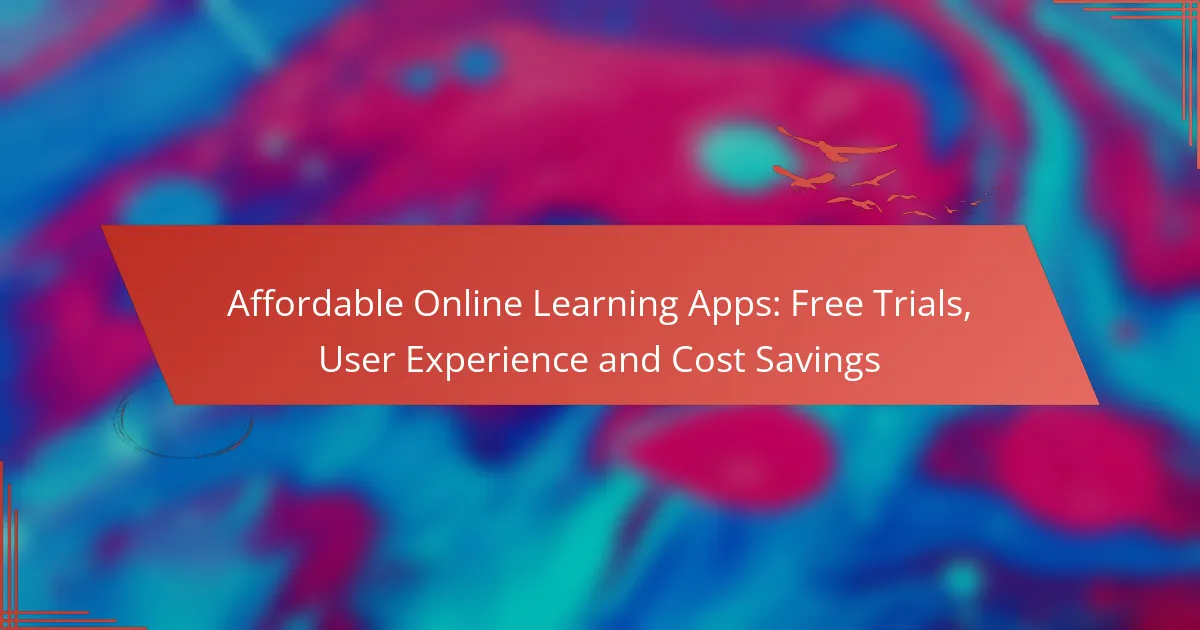Affordable online learning apps offer a blend of effective educational content and user-friendly experiences, making them accessible to a wide audience. Many platforms provide free trials, enabling users to assess features and content quality without financial commitment. The overall user experience can greatly influence engagement, with factors such as interface design and mobile accessibility playing crucial roles in effective learning.

What Are the Best Affordable Online Learning Apps?
The best affordable online learning apps combine effective educational content with user-friendly experiences and cost-saving options. Many of these platforms offer free trials, allowing users to explore their features before committing financially.
Khan Academy
Khan Academy is a free online learning platform that provides a wide range of subjects, including math, science, and humanities. Its interactive exercises and instructional videos cater to learners of all ages, making it a popular choice for students and self-learners alike.
The platform is entirely free, supported by donations, which means users can access high-quality educational resources without any financial commitment. However, it may lack some advanced features found in paid platforms, such as personalized learning paths.
Coursera
Coursera partners with universities and organizations to offer courses across various fields, often featuring free trials for many programs. Users can access a mix of free and paid content, with the option to earn certificates for completed courses.
While many courses are free to audit, obtaining a certificate typically requires a fee ranging from $30 to $100. This flexibility allows learners to explore subjects without initial costs, but they should be aware of potential expenses if they choose to pursue certification.
Udemy
Udemy is a marketplace for online courses, where instructors create and sell their content. Users can find courses on a vast array of topics, often at discounted prices during sales, making it an affordable option for many learners.
Prices for Udemy courses vary widely, typically ranging from $10 to $200. While many courses offer lifetime access, users should check reviews and ratings to ensure they choose high-quality content that meets their learning needs.
Skillshare
Skillshare focuses on creative skills, offering classes in areas like design, photography, and writing. The platform operates on a subscription model, providing unlimited access to courses for a monthly fee, often with a free trial available for new users.
The subscription typically costs around $15 per month, but discounts may apply for annual plans. Users should consider their interests and the number of courses they plan to take to determine if the subscription model is cost-effective for them.
edX
edX offers a wide range of university-level courses, many of which can be audited for free. Users can access high-quality educational content from institutions like Harvard and MIT, with the option to pay for certificates upon completion.
While auditing courses is free, verified certificates usually cost between $50 and $300. This model allows learners to explore academic subjects at no cost while providing a pathway to certification for those who want to demonstrate their achievements.

How Do Free Trials Work for Online Learning Apps?
Free trials for online learning apps allow users to explore the platform’s features without any financial commitment. Typically, these trials last for a limited time, giving users a chance to evaluate the content and user experience before deciding on a subscription.
Trial duration examples
Trial durations can vary significantly among online learning platforms. Commonly, free trials last from 7 to 30 days, with some apps offering a full month to entice users. For instance, platforms like Skillshare and Coursera often provide 14-day trials, while others may extend up to 30 days for new users.
It’s essential to check the specific terms of each app, as some may offer shorter trials during promotional periods or for specific courses. Always note the start date to avoid unexpected charges once the trial ends.
Access limitations during trials
During free trials, access to content may be restricted compared to full subscriptions. Some platforms limit users to specific courses or exclude premium features, such as quizzes or certificates. For example, while you might access a selection of courses on Udemy, certain advanced classes could be locked.
Be aware of these limitations to make the most of your trial. Focus on exploring available resources and features that interest you, and consider whether the full subscription meets your learning needs before the trial expires.

What Is the User Experience Like for Popular Learning Apps?
The user experience for popular learning apps varies significantly, impacting how effectively users engage with the content. Key factors include interface design, mobile accessibility, and interactive features that enhance learning.
Interface design of Coursera
Coursera’s interface is designed for clarity and ease of navigation, featuring a clean layout that allows users to quickly find courses and track their progress. Users can access course materials, assignments, and forums from a centralized dashboard, which enhances the overall learning experience.
Consider the use of visual elements like progress bars and completion certificates, which motivate learners. The platform also provides filters to sort courses by subject, level, and duration, making it easier to find suitable options.
Mobile experience of Udemy
Udemy offers a robust mobile app that allows users to learn on the go, with features optimized for smaller screens. The app supports offline access, enabling learners to download courses and study without an internet connection.
Users appreciate the ability to watch videos at varying speeds and take notes directly within the app. However, some may find that not all courses are fully optimized for mobile, which can affect the learning experience.
Engagement features in Skillshare
Skillshare emphasizes community engagement through project-based learning and peer feedback. Users can participate in discussions, share their projects, and receive critiques, fostering a collaborative environment.
The platform also includes features like live classes and workshops, which enhance interaction with instructors. To maximize engagement, learners should actively participate in discussions and complete projects to benefit from the community-driven approach.

How Do Online Learning Apps Save You Money?
Online learning apps save you money by offering flexible pricing models and eliminating many traditional education costs. Users can access a wide range of courses at a fraction of the price of in-person classes, often with free trials to test the platform before committing.
Subscription vs. one-time payment
Many online learning platforms operate on a subscription model, allowing users to pay a monthly or annual fee for access to a library of courses. This can be more economical than one-time payments for individual courses, especially if you plan to take multiple classes over time.
One-time payments can be beneficial for users who prefer to pay for specific courses without ongoing commitments. However, they may end up being more expensive if you take several courses, as subscriptions often provide significant savings for avid learners.
Discounts and promotions
Online learning apps frequently offer discounts and promotions, such as seasonal sales or referral bonuses, which can further reduce costs. Signing up for newsletters or following platforms on social media can keep you informed about these opportunities.
Some platforms provide discounts for students or educators, making it essential to check eligibility for any available offers. Additionally, bundling courses or subscribing to premium plans can yield further savings.
Cost comparison with traditional education
Comparing online learning apps to traditional education reveals significant cost differences. Traditional college courses can range from hundreds to thousands of dollars per credit hour, while online courses often cost a fraction of that, sometimes as low as $10 to $50 per course.
Moreover, online learning eliminates costs associated with commuting, housing, and materials, which can add up quickly in traditional settings. This makes online education a more accessible and budget-friendly option for many learners.

What Are the Key Features to Look for in Learning Apps?
When selecting learning apps, focus on features that enhance your educational experience, such as content variety, instructor qualifications, and user reviews. These elements can significantly impact the effectiveness and enjoyment of your learning journey.
Content variety
Content variety refers to the range of subjects and formats offered by a learning app. Look for apps that provide diverse materials, including videos, quizzes, articles, and interactive exercises. This variety can cater to different learning styles and keep users engaged.
For example, platforms like Coursera and Udemy offer courses across numerous disciplines, from programming to photography. A good app should also update its content regularly to reflect current trends and knowledge.
Instructor qualifications
Instructor qualifications are crucial for ensuring quality education. Check the backgrounds of instructors, including their education, experience, and expertise in the subject matter. Well-qualified instructors can provide valuable insights and enhance the learning experience.
Many reputable apps display instructor profiles, allowing users to assess their credentials. For instance, platforms like LinkedIn Learning often feature industry professionals who bring real-world experience to their teaching.
User reviews and ratings
User reviews and ratings offer insights into the effectiveness and user satisfaction of learning apps. Before committing to an app, read through user feedback to gauge the overall experience and identify any potential issues.
Look for apps with high ratings and positive comments regarding content quality, ease of use, and customer support. Websites like Trustpilot or app stores can provide a wealth of user opinions that help inform your choice.



